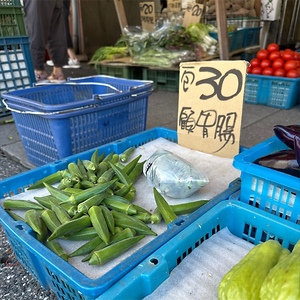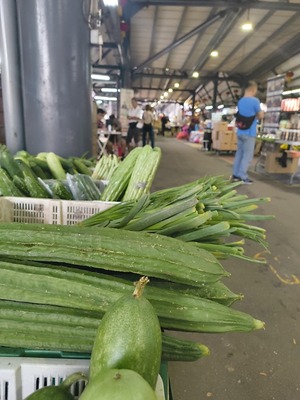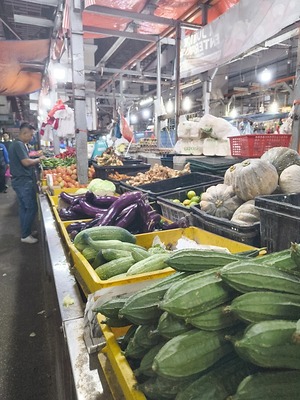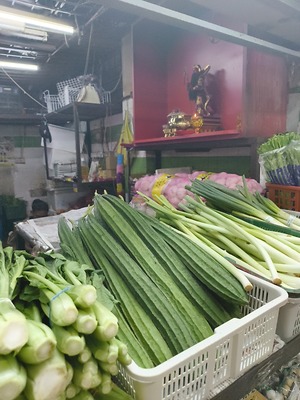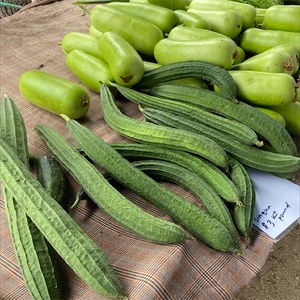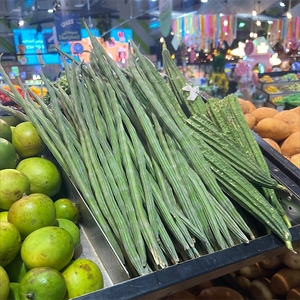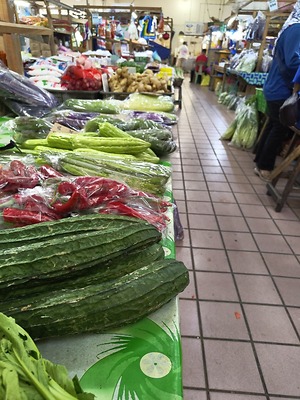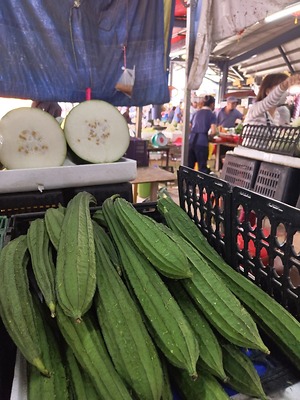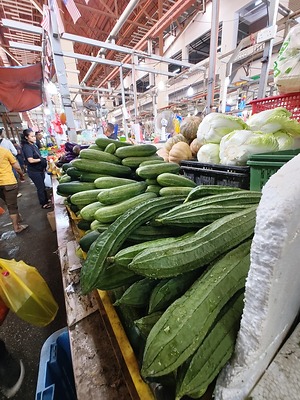

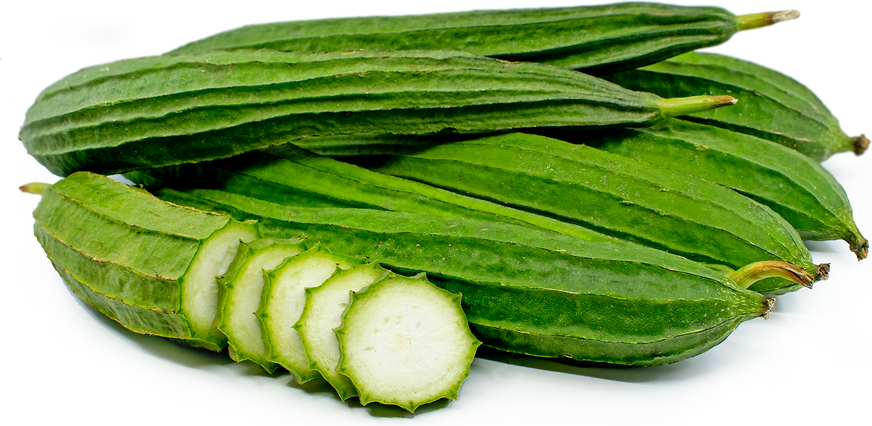
Chinese Okra
Estimated Inventory, 20 lbs : 0
Description/Taste
Chinese okra varies in size and appearance, depending on the specific variety and maturity at harvest. Most types seen in fresh markets for culinary use are collected when young and smaller, averaging 15 to 30 centimeters in length and 5 to 10 centimeters in diameter. Chinese okra has a slender, elongated, cylindrical shape with tapered, pointed ends. The species features 8 to 10 evenly spaced, defined ridges, and these ridges have angular, sharp edges. When sliced in half, the ridges give the gourds a pointed, star-like shape. The skin is thin, dark green, and matte with a rough, textured, and firm feel. Underneath the surface, the white flesh is spongy, soft, and smooth, filled with a fine and dense network of fibers. The flesh is crunchy, crisp, and tender when young, expanding and becoming tough, fibrous, and inedible when mature. The flesh also encases tiny white seeds that turn black and become larger with age. Young Chinese okra is edible raw or cooked and develops a soft texture reminiscent of eggplant when cooked. The flesh is absorbent and will swell with whatever liquid it is cooked in. The skin is peeled before consumption, and the flesh is subtly sweet, refreshing, vegetal, and green.
Seasons/Availability
Chinese okra is available year-round in tropical climates, with a peak season in the summer and fall.
Current Facts
Chinese okra, botanically classified as Luffa acutangula, is an Asian species belonging to the Cucurbitaceae family. The fruits, also known as gourds, grow on herbaceous vines extending 3 to 10 meters in length and have been cultivated throughout history as medicinal, culinary, and conventional crops. The name Chinese okra is a misnomer as it is unrelated to okra, Abelmoschus esculentus, which is also used as a culinary ingredient. It is rumored that the species acquired the name Chinese okra for its similar appearance to okra but growing to much larger sizes. Chinese okra is also known worldwide as Angled Luffa, Silk Squash, Angled Sponge Gourd, Ribbed Loofah, and Ridged Gourd in English-speaking regions. The species is called Singua, Si Gua, Sheng Melon, and Guagdong Loofah in China, Penghu Loofah in Taiwan, Torai, Tori, and Turai in India, Buap Liam in Thailand, Tkado Hechima in Japan, Patola in the Philippines, and Muop Khia in Vietnam. It is important to note that there are five species collectively called Luffa gourds. Chinese okra is a common home garden plant, which can appear thin and short to long and thin, depending on the specific variety. Chinese okra is also prevalent in fresh markets, especially in Asia, and is utilized as a culinary ingredient for fresh and cooked savory culinary preparations.
Nutritional Value
Chinese okra is a source of fiber to aid digestion and has been medicinally used in natural Asian medicines as an ingredient to clear heat and phlegm from the body. The species is also believed to promote circulation and contains vitamins A, B, and C to strengthen the immune system and maintain healthy organs. Beyond vitamins, Chinese okra contributes minerals like calcium, phosphorus, iron, potassium, magnesium, and manganese. Calcium and phosphorus support bone and teeth health, while iron develops the protein hemoglobin for oxygen transport through the bloodstream. Potassium assists the body in balancing fluid levels, magnesium helps control nerve functions, and manganese is involved in metabolism.
Applications
Chinese okra has a mild, subtly sweet, and vegetal flavor suited for fresh and cooked preparations. Younger versions are edible raw and can be peeled and cut into bite-sized pieces for salads, dips, and slaws. Chinese okra is also customarily stir-fried, steamed, or fried. The skin must be peeled before use, and the flesh holds its shape and does not discolor during cooking. Chinese okra can be used similarly to zucchini in recipes. In Asia, the species is commonly stir-fried with meat as a main dish or simmered into soups and stews. The flesh is highly absorbent and will swell with liquid, enhancing the flavor of the gourd with each bite. Chinese okra is also hollowed, stuffed with noodles, spices, and meat, and steamed as a simple dish. In China and Taiwan, the species is incorporated into a clam and egg soup or stir-fried with eggs and other vegetables. Chinese okra is also mixed into noodle dishes in Vietnam or simmered in curries in Thailand. Almondingas is a well-known soup in the Philippines that uses thin pieces of Chinese okra with pork meatballs and noodles. Chinese okra is also dipped in chickpea batter and fried in India, or cooked in gravies, dals, and lentils. While less common, the species is occasionally pickled as a tangy condiment. Chinese okra pairs well with seafood like clams, shrimp, and fish, meats including pork, beef, and poultry, and aromatics such as garlic, ginger, chives, coriander, bonito flakes, sesame oil, and soy sauce. Whole, unwashed Chinese okra has a short shelf life and should be stored for 2 to 3 days in the refrigerator’s vegetable drawer.
Ethnic/Cultural Info
Chinese okra is traditionally peeled and sun-dried into a fibrous, sponge-like material. This dried material is commonly known as a luffa or loofah and is used for bathing, cleaning, and even cooking. The two most common gourds dried for luffas are Luffa acutangular, Chinese okra, and Luffa aegyptiaca, Smooth Sponge Gourd. Chinese okra, or Angled Sponge Gourds, have a slightly rougher feel than Smooth Sponge Gourds, making them suitable for utility cleaning like scrubbing pots and pans. Smooth Sponge Gourds are popularly used for bathing exfoliators and as a mat to line steamers. One of the most notable uses for Angled Sponge Gourds is to clean inkstones, one of the “Four Treasures of the Study” in China. Inkstones have been made since the Warring States Period from 475 to 221 BCE and are collectively known as an essential element for scholars along with brushes, ink, and paper. Many variations of inkstones have been made throughout history, with the most popular being made from natural stone. The stone was intricately designed, carved, and polished, and finished stones were carried by teachers, artists, emperors, and students as an indispensable tool to make ink for writing and drawing. Angled Sponge Gourds were favored as a natural scrubber for inkstones as they could clean without damaging the stone.
Geography/History
Chinese okra is believed to be native to tropical regions of South Asia and has been growing wild since ancient times. The species was later spread throughout tropical and subtropical areas of Southeast Asia and East Asia and became a cultivated crop in southern China sometime during the Tang and Song dynasties, between 618 and 1279 CE. It was also established in home gardens as a culinary and medicinal ingredient throughout Asia. Today, commercial cultivation of Chinese okra primarily occurs in Asia and Africa. The species is also planted as a specialty home garden crop worldwide. When in season, fresh Chinese okra is sold directly by the grower or in local markets. It is also found through Asian grocers in larger cities worldwide.
Recipe Ideas
Recipes that include Chinese Okra. One



